#fieldwork
Text
I've been doing a lot of volunteer fieldwork with these guys recently so I thought I might as well do an infodump about them here.
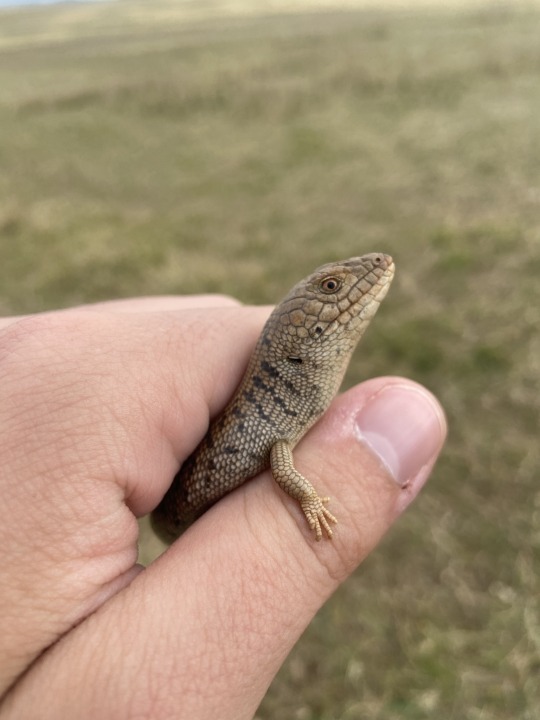
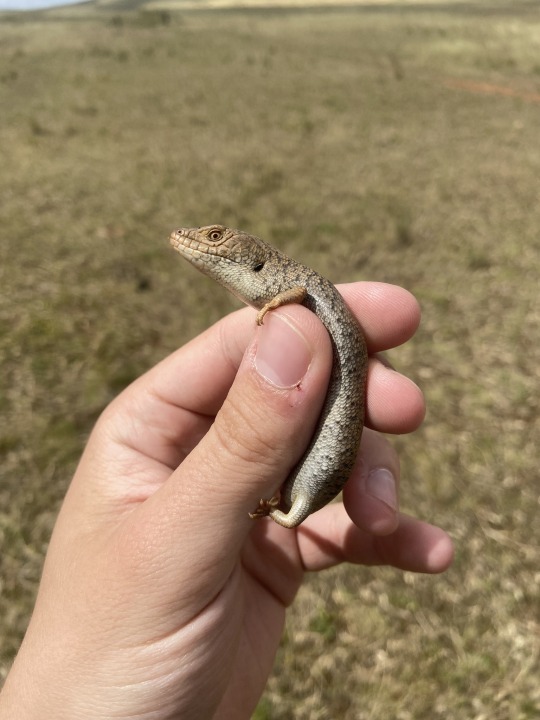
The pygmy bluetongue skink (Tiliqua adelaidensis) is one of the most unique and unusual members of the Tiliqua genus, which includes the true bluetongues as well as the sleepy lizard/shingleback. However, the pygmy bluetongue actually lacks the blue tongue the group is named after, having a pink tongue instead! As its scientific name suggests, it is quite a range restricted species, being found only in open grasslands north of Adelaide, South Australia, as far north as Peterborough. Historically they ranged more extensively across the Adelaide Plains, as far south as Marion, but due to the destruction of suitable habitat they now occur no further south than Kapunda.
While most bluetongues are notable for their large size amongst skinks, with several species regularly exceeding 30 cm in length, the pygmy bluey lives up to its name by measuring a measly average of 9 cm long from snout to vent. This is actually still a fair size compared to the average skink, but it's miniscule by bluetongue standards. Even more notable than their size however are their habits, for they are the only species of lizard that is specialised to live exclusively in old spider burrows! The burrows of both trapdoor and wolf spiders are used, but trapdoor burrows are preferred in most instances.

Pygmy bluetongues spend the majority of their lives within these spider burrows, leaving only to defecate, seek out mates and disperse. The average length of time a lizard spends in a particular burrow is highly dependant on the individual - some are sedentary and spend many years within a single burrow, while others will move around fairly frequently. As well as places to shelter and raise their young (they have parental care, it's very cute), pygmy bluetongues also use the burrows as ambush sites, waiting at the top for suitable prey, usually a mid-sized arthropod, to stray close enough for them to quickly dart out and drag them into the depths.
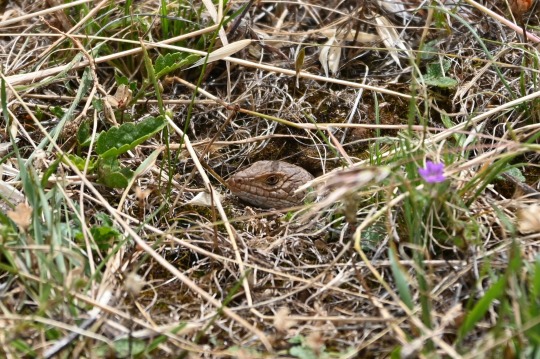
but here's the ambusher
The chief natural predators of pygmy bluetongues are raptors and brown snakes, and sheltering in the burrow is the main defence against both of these threats. Their burrows are often wide enough for a brown snake to enter, but not wide enough for them to open their mouths in - this means all the brown snake usually gets by pursuing a sheltering pygmy is an angry lizard attacking its face, forcing it to retreat.
The lazy lifestyle of the burrow-stealing pygmy bluetongues is certainly unique, and also explains why they have been such an elusive species since they were first discovered by Western scientists in the 1860s. Rarely seen or collected, their habit of inhabiting spider burrows remained undiscovered for the longest time, and by the 1960s they had become so hard to find that they were believed to be extinct. That was until, in 1992, a pygmy bluetongue was found inside the stomach of a roadkill brown snake by amateur herpetologist Graham Armstrong, confirming their status as a Lazarus of the lizard world.
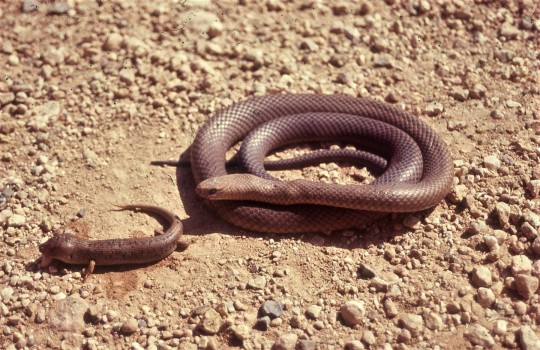
The historic rediscovery of the pygmy bluetongue
(Image credit: Graham Armstrong)
Our previous assumptions of extinction were fortunately premature, but the pygmy bluetongue skink is in serious trouble nonetheless. While they are able to live in a variety of different grassland types, both native and exotic, the extensive modification of their entire distribution through cereal cropping and urbanisation has led to their populations becoming very small and fragmented, giving them a ranking of Endangered on the IUCN Red List. Almost all of these populations are on private land (often grazed by sheep), which makes protecting and/or studying them particularly difficult and complex.
However, when it comes to future threats to the species, climate change is easily the most worrying. As Australia becomes ever hotter and drier, their small remaining distribution is likely to become largely unsuitable, threatening the existence of the entire species. To combat this, researchers are currently investigating the viability of translocating populations further south to areas with cooler climates, providing a safeguard if they do indeed disappear from their remaining natural distribution.
But how do you study a lizard that lives exclusively in small spider holes? Well, if you want to catch them, there's only one tool for the job - the humble fishing rod. Not any special fishing rod either, just a regular rod with a poor mealworm shoddily tied to the end. Using this, you can engage in a tug of war with the lizards until, if they aren't being too difficult, you're able to pull them completely out of their burrow and catch them to perform the necessary measurements and processing. David Attenborough kindly demonstrates this technique in Life in Cold Blood, although in his case the lizard was steadfast in remaining in the burrow!

the sacred tool of the mighty lizard fishermen
returned to their abode
Two additional Fun Pygmy Facts:
Fun Pygmy Fact #1 - The closest living relative of the pygmy bluetongue is the sleepy lizard!
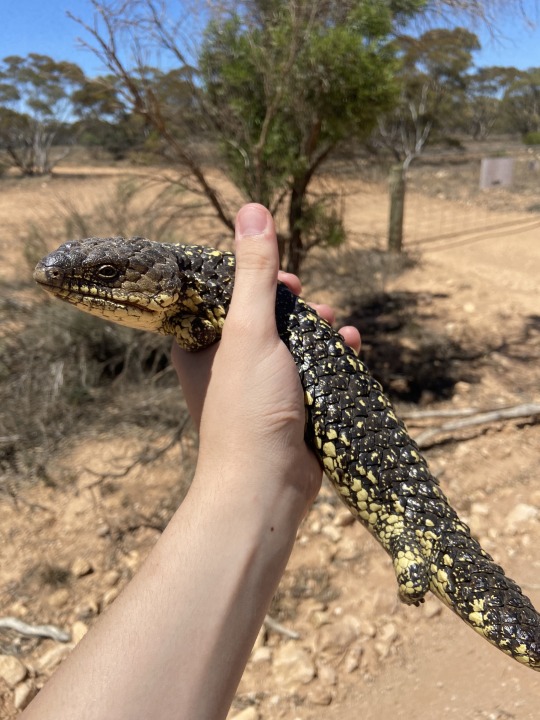
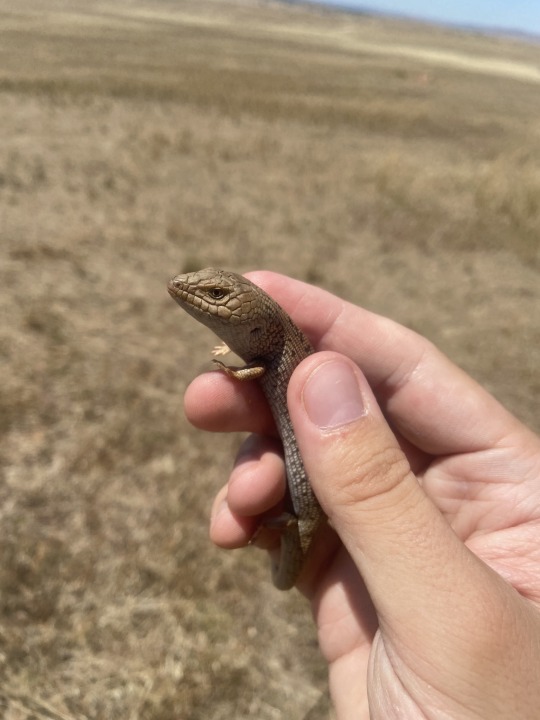
cousins!
Fun Pygmy Fact #2 - Wooden artificial burrows purpose-made for pygmy blueys have proven effective, and the lizards inhabiting them even tend to be in better body condition than those in natural burrows!

#australian wildife#wildlife#reptile#lizard#skink#tiliqua#bluetongue#animal facts#herpetology#natural history#fieldwork#infodumps#my stuff
855 notes
·
View notes
Text
Things I hate about archaeology -as an archaeologist-
Ungodly hours changing every week. What healthy sleeping pattern?
Rain that just keeps pouring for hours and hours with material that’s water sensitive and a boss that wants you to continue. I don’t work well when I look and smell like a street dog
Working on “your field of specialty”. Don’t think it’ll ever happen to me.
People with no knowledge of your line of work that decide everything for you
No one knows what archaeology is about, no one wants to know. Worse is being declared mad.
Every archaeologist has OCD. Which makes it hard to please yourself and your superior
Why does sand end up everywhere?
#archaeology#field archaeologist#field archaeology#fieldwork#geology#history#anthropology#geography#archaeology meme#archaeology problems#history meme#geology meme#Indiana jones#sand#rain#ocd
746 notes
·
View notes
Text
Our newest find – a skull of a Tagarosuchus kulemsini, a small protosuchian crocodyliform from the Early Cretaceous (about 125-113 mln y.o.)


Shestakovo-3. 07/28/2023
These photos were taken immediately after the croc was found in a waste rock dump)
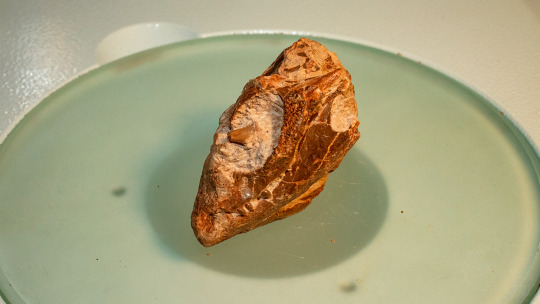
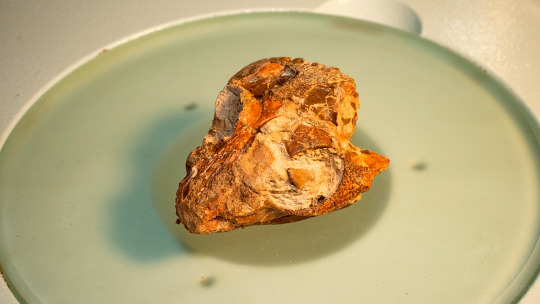


Photos by Yaroslav Zheleznov.
… and these after gluing and some cleaning.
#Ilek formation#cretaceous period#Shestakovo#tagarosuchus#crocodyliform#paleo#fossils#animal bones#animal skulls#crocodile#geology#paleontology#biology#science#fieldwork#excavations#looks like it has smth in its eye heh
284 notes
·
View notes
Text
Hi geobuddies!!!
So the spring semester has started and we’re loving it! Besides that my geologist friend has a question!
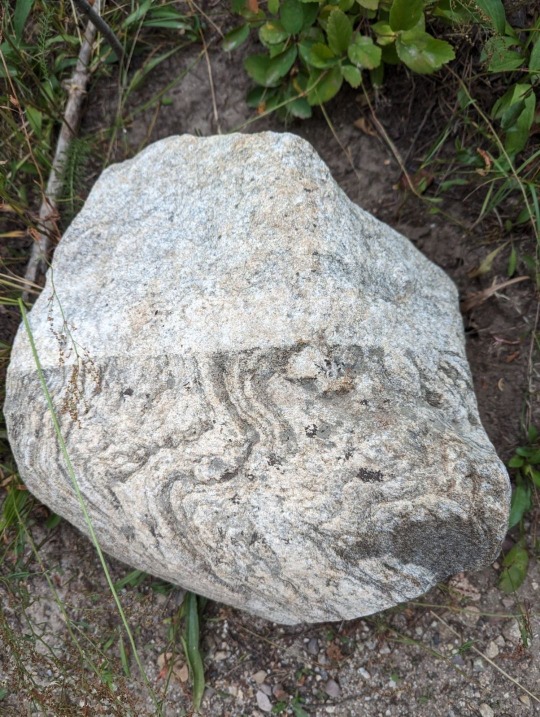
She found this dope ass rock! It’s was found in Grand Teton National Park, Jenny Lake Loop! Anyone have any guesses?
P.S. I know you're not supposed to do rock ID from pictures but look how cool!!
128 notes
·
View notes
Text
the nice thing about living long enough in one place is that there comes a day when you find yourself saying hello to your librarians on the tram and the local shop owners will greet you when you’re out and about and the baker will smile and nod at you in the supermarket and you will bump into a friend at a pedestrian crossing and walk with them a little bit. and it’s really really nice
73 notes
·
View notes
Text

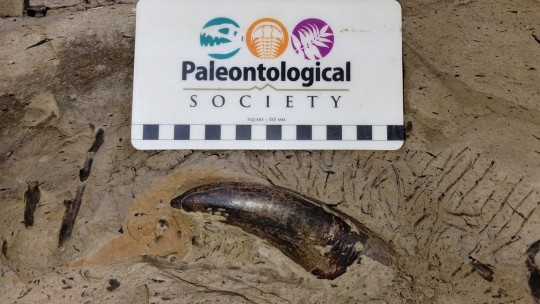




Bighorn Bonebed near Hinsdale, MT, 2023 field season. This site preserves multiple Brachylophosaurus sp. who died in a group.
#palaeontology#paleontology#paleoblr#palaeoblr#fossils#fossil#dinosaurs#bighorn Bonebed#fieldwork#photography#Hinsdale#animals#fieldwork 2023
128 notes
·
View notes
Text
FOSSIL FRIDAY: CERATOSAURUS
Ceratosaurus, the "horned lizard" is probably one of the coolest dinosaurs discovered. It was described by Othniel Charles Marsh based on a nearly complete specimen from Garden Park, Colorado.
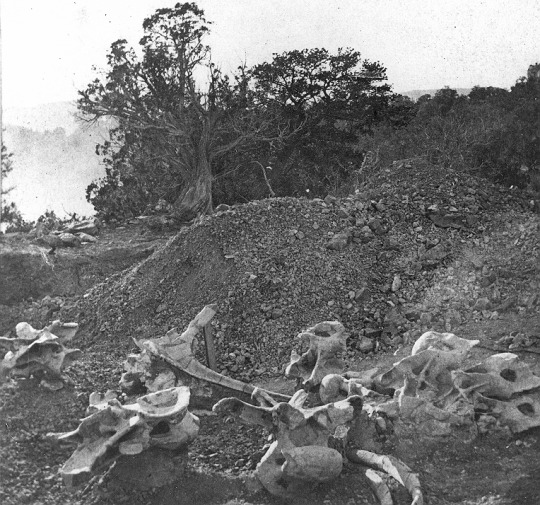
It is one of four large theropods in the Morrison Formation of the U.S. and the Lourina Formation of Portugal. There is currently only one accepted species: Ceratosaurus nasicornis.
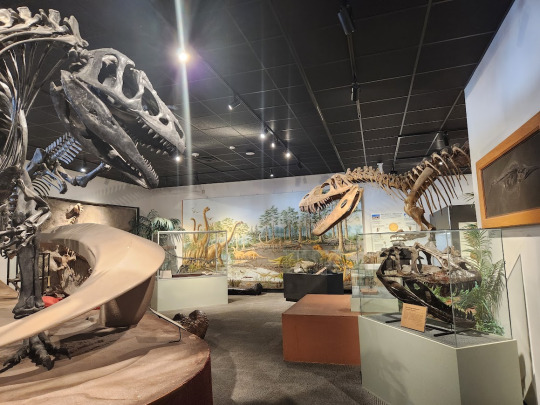
Allosaurus, Torvosaurus and Ceratosaurus at the BYU Museum of Paleontology.
Ceratosaurus is a medium-sized theropod. The type specimen is about 17 ft (5.3 m) long but other specimens indicate it could get more than 20 ft long. It is characterized by deep jaws that supported proportionally long, blade-like teeth, a prominent, ridge-like nasal crest, and a pair of crests over the eyes making it appear very dragon-like.

It had fairly short arms especially compared to its contemporary rivals. Each hand had four fingers with the three larger ones sporting a claw.

It also had a row of osteoderms that ran down it's neck, back and tail.
It is thought that Ceratosaurus was a solitary hunter. None have ever been found in close proximity to another. In a paper written by Donald M. Henderson in 1998, he stated that Ceratosaurus' taller skull indicated a resistance to bending. Its long, broad teeth would present increased frictional resistance to penetration due to increased surface area.

It had powerful adductor muscles that would increase the overall stresses on the entire skull. Having a deeper skull would relieve that by increasing the flexural rigidity and thus the strength. Think pit bull or hyena.

Ceratosaurus is only represented by a handful of specimens, far more common than Torvosaurus but still much less common than Allosaurus. There are two ideas floating around about why this is. One, there simply weren't as many of them. Two, it preferred a habitat that just didn't preserve fossils as well. Whatever the case may be, I hope that we can help answer some of these questions with the potential specimen we found at the Evil Tree Bonebed.

Possible Ceratosaur ischium (and it's a whopper for size).
Want to help recover the Ceratosaurus? Then come join us this summer at Colorado Northwestern Community College! Check out the link for more info. Hope to see you there!
63 notes
·
View notes
Text


THE MADNESS BEGINS. Sixteen gay-as-hell books compete for the ultimate prize: bragging rights.
Last year's Queer Books March Madness was dominated by underdog @joydemorra's Hunger Pangs: True Love Bites. Will another sleeper contender snag the (extremely metaphorical) trophy, or will a heavy hitter like Gideon the Ninth claim the title? YOU DECIDE.
Voting for Round 1 is up in our Insta stories from 10 AM 3/17 to 10 AM 3/18 (EST). Votes in the comments ✨will not count!✨
All the nominations are from our bracket are available for free through QLL’s Libby collection. Check 'em out and get reading: https://tinyurl.com/QLL-MM24
Want to support our mission of by connecting LGBTQ+ people with literature, information, and resources that celebrate our community? Donate at the link in our bio!
<3 HAPPY MADNESS. 🏀📚☄️
#queer liberation library#qll#march madness#queer books#gideon the ninth#tlt#empress of salt and fortune#the spirit bares its teeth#a snake falls to earth#the male gazed#pageboy#fieldwork#hi honey i’m homo#boys weekend#freshwater#the sunbearer trials#the bruising of qilwa#don’t want you like a best friend#cool for the summer#legends & lattes#the space between worlds
31 notes
·
View notes
Text
My materials and methods section for mycology fieldwork is getting… absurd. My field site is underwater now in a lake which is not ideal bc I have to dip stuff in alcohol and light it on fire which is kind of impossible with just 2 hands to carry the stuff out. The lake is also full of toxic metals (lead, mercury, arsenic etc) and I suspect there are a lot of dead birds (I counted 13 in 30 ft in January). If I can avoid putting my face in that would be ideal.
So I’m thinking of tying an inner tube with a bottom to a carabiner and hooking that to the straps of my waders so I can have a little floating lab???
121 notes
·
View notes
Text

For Truth's Sake is a solo-journaling game based in the ideas of anthropology and field work. You play as an anthropologist living and working in a community of your choosing. Pull cards and roll dice to determine who you talk to/where you go and what questions to ask. The game uses a "trust points" system - you gain and lose trust points by playing and interacting with NPCs and locations!
THE SRD | $2 with community copies available || itch.io | ko-fi
This SRD provides you with core rules and explanations on how to build a setting to explore on your own time!
Also comes with examples and questions to get started. Included is a creative license for making your own settings.
SETTINGS
Each setting comes with 20 NPCs, 12 locations, and 12 events that you can interpret as you wish. They also come with the full core rules and set of NPC and Location questions.
WEREWOLF NEIGHBORHOOD | $5 || itch.io | ko-fi
A pack of werewolves lives together in a suburban area. They hang out, connect with each other, even hunt together. Do they live in a world where they can openly be werewolves? Or do they have to hide who they are? How is the pack set up? Do they talk to other packs? Talk to NPCs, explore locations, and attend events to find out!
URBAN WITCHES | $5 || itch.io | ko-fi
A coven of witches lives, eats, and games together in an apartment building in a large city. Is this a city full of magic? Or are they the odd ones out? How do they connect with each other? With other people in the city? With their landlord? Explore the NPCs and Locations to discover all there is to find out.
FEYWILD INN | $5 || itch.io | ko-fi
An inn nestled in an odd space between what we consider reality and the wilderness that some call the feywild is home to an interesting group of fey and humans alike. Are they living together in harmony? Are the fey preying on the humans? Or is your bias showing through?
Remember, it’s polite to eat what a person that has invited you in offers you.
#for truth's sake#indie ttrpg#indie game#solo journaling game#moon.txt#my game#anthropology#fieldwork#pls reblog <3#every reblog matters
109 notes
·
View notes
Text
Bonus 79: Field Notes on linguistic fieldwork - Interview with Martha Tsutsui Billins
Linguists often do research by interviewing people from a particular linguistic community. Sometimes these communities are nearby, sometimes very far away. Sometimes it's a community that the researcher is themselves a member of, sometimes this involves first building relationships with a community where the researcher is an outsider.
In this bonus episode, Lauren gets enthusiastic about the process of doing linguistic fieldwork with Dr. Martha Tsutsui Billins, an Adjunct Teaching Fellow at California State University Fresno, whose name you may recognize from the credits at the end of the show! We talk about Martha's research on politeness in Amami, building relationships on the Ryukyu Islands in Japan, and the role of outsider scholars in language documentation. We also talk about her relationship with the academic job market as an adjunct, her podcast Field Notes interviewing many linguists about their experiences doing linguistic fieldwork, and her role on the Lingthusiasm team helping us research examples for episodes.
Listen to this interview about linguistic fieldworks with Dr. Martha Tsutsui Billins, and get access to many more bonus episodes by supporting Lingthusiasm on Patreon.
76 notes
·
View notes
Text
Doing sleepy lizard fieldwork in the Mid Murray today involved bountiful encounters with goofy fellas as usual
This guy is somehow missing the keratin on most of his large tail scales, revealing the bony scutes (osteoderms) beneath. We’re not exactly sure how this occurred, hopefully he’s not scuffed up too bad, but it is quite cool to look at


Then there’s grumps over here, sucking on his pacifier. We named him Cupcake after his delightful personality


Cupcake is now getting clamped because he’s naughty and bit someone (actually just taking a measurement of head depth)
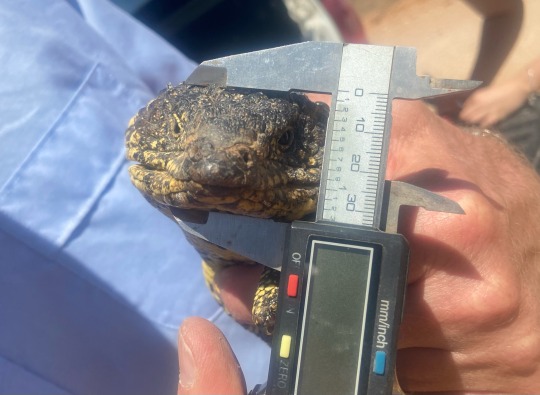
Polite gentleman patiently getting his tail measured (not a sleepy lizard, doesn’t want to be here)
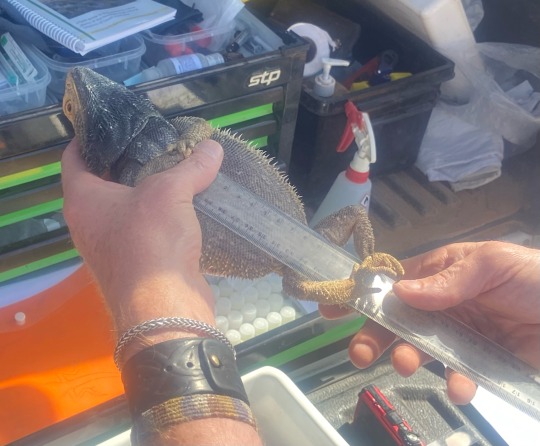
#south australia#australian wildlife#wildlife#reptile#reptiles#lizard#lizards#skinks#bearded dragon#shingleback#fieldwork#herpetology#my stuff
486 notes
·
View notes
Text
The evil trinity of archaeology
1) sand
2) sweat
3) sunscreen
#archaeology#archaeology humor#field archaeology#field archaeologist#fieldwork#archaeology problems#archaeology stereotypes#geology#geography#history#meme#archaeology meme#history meme#geology meme#indiana jones#outdoor work#sunscreen
567 notes
·
View notes
Text
August 7th was a big day for me. Finally. After 5 years of participating in fieldworks, I found a skeleton of a theropod!
Well, this is actually not a full skeleton, but! For all the years of research on the Shestakovo location since 1953, only single bones of various theropods have been found here. And in general, all previously found here articulated skeletons belong only to psittacosaurs... So... this is really something new.


The wet sandstone was very brittle and crumbled at the touch of fingers exposing the fossil.
However, finding something is only half the case. You have to take it with you somehow and not break it. The fossil was encased in a single piece of sandstone weighing at least a third of a ton, lying on the bank of the Kiya River and half submerged in water. A high sheer cliff overhangs the shore, and the surface below is littered with cobblestones, on which no one truck can pass. The only way to take the fossil is to float it down to the gentle shore.
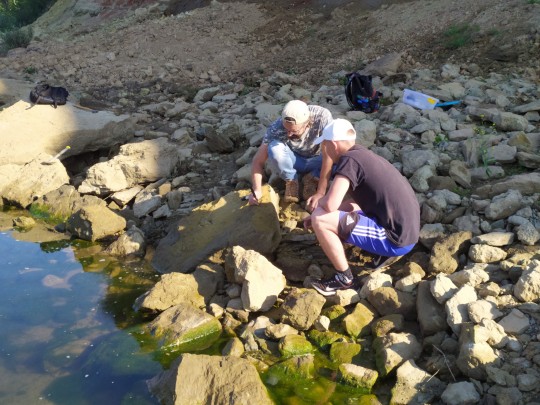
But there was a small problem... We had no boat or something. Fortunately, a local resident agreed to transport the block with the fossil on his own rubber boat. This was a small two-person rubber boat that can barely withstand the weight of the rock block. In addition, it turned out that the tightness of the air chamber of the boat is broken, so it needed to be continuously pumped up, otherwise the boat would have just sunk. x') But after a couple of hard hours, the fossil was finally loaded into the car... which couldn't move because it got stuck in the mud.

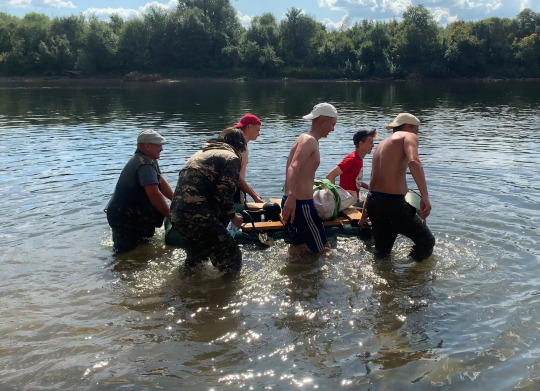
In parallel with all these events, I fought for the safety of the fragile bone, which was in a piece that broke off from the monolith. Its transportation took another day.
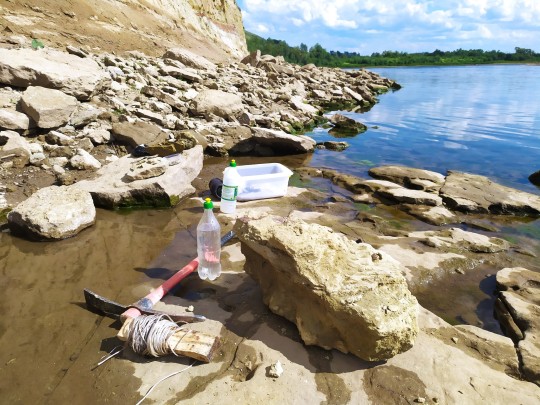

Location: Shestakovo-1 «Malyi Yar», Kiya River, Western Siberia. 08/08/2023
Now the fossil is in the camp. After drying and removing excess rock, it will be sent to the city for tomography. And maybe after that we will find out the taxonomic affiliation of the found prehistoric animal.
#cretaceous period#ilek formation#shestakovo#fieldwork#fossils#dinosaurs#dinosaur fossils#theropods#paleo#paleontology#geology#biology#science#sorry for my english
305 notes
·
View notes
Text


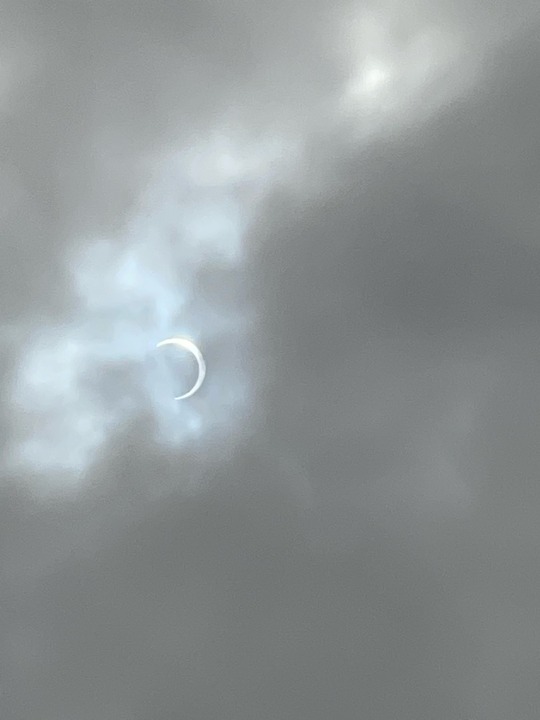


Went to Big Bend National Park in Texas!!!
First two pictures are along the Emory Peak trail with a view of what they call The Window. The rocks are from a rhyolitic lava flow.
Third picture is of the eclipse.
Fourth is of mini potholes or vugs from a random rock I climbed into.
Fifth is the trail heading to the Rio Grande depicting the Santa Elena Canyon.
#geology#rocks#justgeologythings#just geology things#minerals#water#fieldwork#geology memes#geologist#i love water#big bend national park#national park
89 notes
·
View notes
Text
but do the toxic yuri enjoyers know about nobody by the crane wives
#tender as a bruise sharper than a razor wraps her tentacles around me like she’ll never let me go#nobodyyyyyy ever loved me like she tells me she does#the crane wives#fieldwork
56 notes
·
View notes